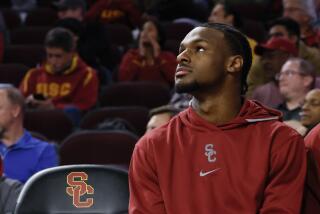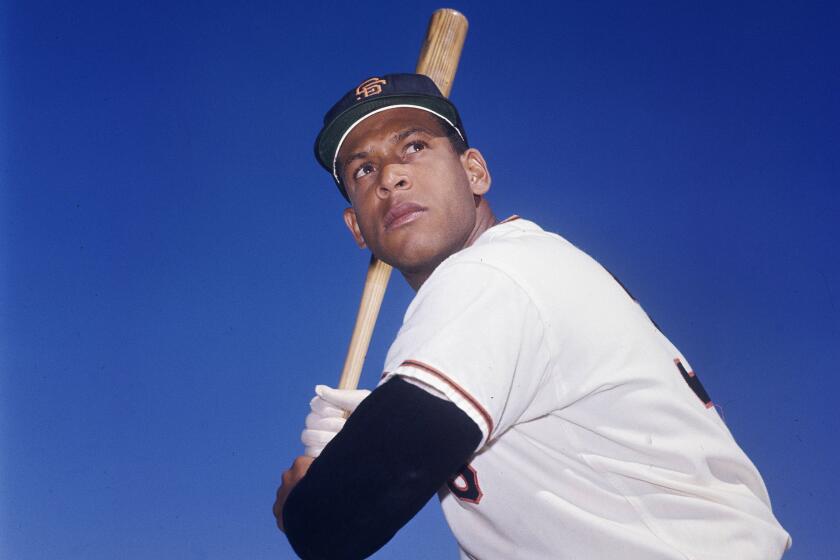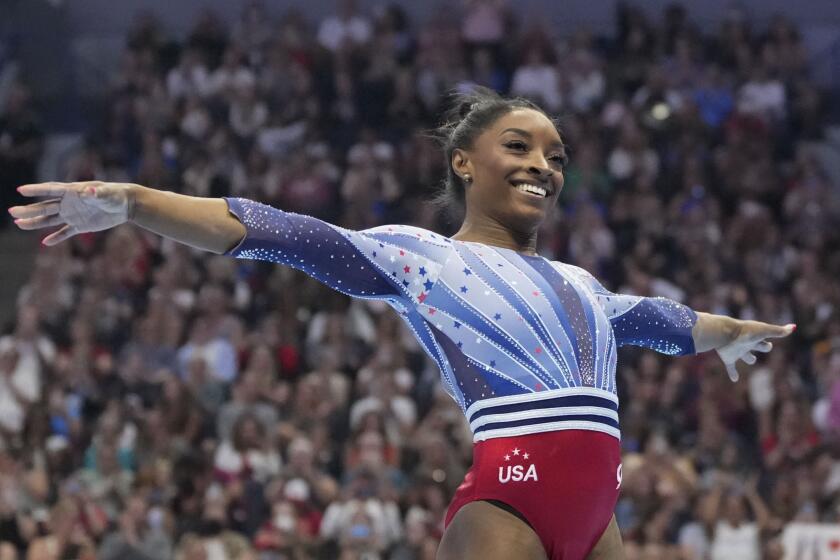7 Floors Decorated in ‘Early Farouk’ : Hofheinz’s Gaudy Suite in Astrodome Being Razed
The old judge was a corker. A real showboat. He built the Astrodome, the first domed stadium, the eighth wonder of the world.
Then he moved into it.
Judge Roy Hofheinz lived in his own stadium, which, when it opened in 1965, was variously dubbed the Valhalla of sports and the world’s largest air-conditioned room. His apartment took up parts of seven floors and had a shooting gallery, a chapel, a putting green and a bowling alley. There was a bedroom with a 24-foot ceiling called the Presidential Suite and a bar called the Tipsy Tavern.
Now, after years of disuse, all that is going. The judge died in 1982 but lost control of the Astrodome long before then. The last time Hofheinz and his wife, Mary Frances, lived in the Dome was 1972.
Where once the suite was very much a part of Astrodome lore, the passage of time has all but erased the memory of the judge’s place in the right field bleachers. Only now, as it is about to be demolished to make way for more seating capacity, are the doors being opened for one last dusty look at Hofheinz’s private playground, one so gaudy and devoid of taste that comedian Bob Hope once called it “early King Farouk.”
“You wonder what kind of mind would think this up,” Chuck Pool, an Astrodome spokesman, said as he paused at the darkened chapel decorated in a Middle Ages motif. Matadors used to pray here before bloodless bullfights.
“He was the epitome of the wild Texas showman,” Pool said.
That he was. He managed to persuade Houston’s Harris County officials to finance what, at the time, seemed almost as daring as the program going on down the interstate at what is now the Johnson Space Center. He talked them into building a domed stadium to free the fans from blood-thirsty mosquitoes and the vagaries of Houston weather.
He’d gotten the idea in Rome, where he had been told the Coliseum was originally covered with an awning. Buckminster Fuller, who invented the geodesic dome, convinced him that the radical new design was possible.
Mini-Skirted Ushers
And so, when the Astrodome was opened in 1965, with mini-skirted ushers called Spacettes and space-suited groundskeepers called Earthmen, Hofheinz was watching from his lavish suite.
From it, he watched the various, sometimes laughable, dilemmas unfold: players losing baseballs in the blinding glare of the clear plastic dome; the grass dying when the dome was painted; the grass being painted green when it died; seeking a grass substitute, which led to the invention of Astroturf; worrying that the air conditioning might variously impede or assist fly balls.
“It really was the most unusual feeling,” Hofheinz’s widow said. “It was like living in a futuristic wonderland. It was like having your own planet. Sometimes we didn’t leave for weeks on end.”
Having said that, though, Mrs. Hofheinz conceded: “It was unusual, don’t get me wrong.”
In Golf Cart and Bathrobe
There is story after story of Hofheinz’s tooling around the Astrodome late at night in a golf cart, wearing a bathrobe and smoking a stogie. It was, after all, his house.
Pool, the Astrodome spokesman, led the way through the Hofheinz apartment, where one room was more unusual than the next. There was the barber chair, with an assortment of old-time hair tonics and massage creams. The game room had a pool table and three nickelodeons, one showing a Douglas Fairbanks thriller entitled “Whose Move Is Next!”
Next door was the Tipsy Tavern, where everything is built off-kilter so that drinkers were off balance. Pool showed the button that Hofheinz used to push after sending a beer hurtling down the bar toward an unsuspecting guest. The button activated an electromagnet that stopped the beer stein only inches from the victim’s lap. Behind the bar was a dumbwaiter, so food could be sent to all floors of the suite.
“Another thing about the judge was that he was an immense eater,” Pool said. “Supposedly, there was a cook who stayed on duty 24 hours a day.”
Shooting Gallery
Pool moved along, feeling his way down the sometimes darkened, dusty hallways, searching for the next light switch. The shooting gallery was a life-size scene of a man surrounded by game animals. The guns rested on a stand lined with Astroturf. In other rooms, the pins on the bowling alley were down, and several old golf balls were strewn about the putting green. Astroturf, of course.
And, at the chapel, Pool showed how eight different plastic slides--designed to look like stained glass--could be inserted in a backlighted circle. Each represented a different faith, so that almost any worshiper could be accommodated. Pool said he did not know of any Astros who had made a point of visiting the chapel for spiritual guidance. For that matter, hardly any of the apartment had been used since Hofheinz sold his interest in the Houston Sports Assn., which owned the Astros, in 1975.
“The one thing that is sad is that, even in the best of times, this was just for the judge and his buddies,” Pool said.
Perhaps. But one question is why building an apartment in stadium, something that seems a bit daffy now, was so breezily accepted back in the ‘60s. Fred Hofheinz, Roy’s son and, like his father, a former mayor of Houston, said it was rather simple.
‘Showbiz Pizazz’
“My father’s success was in a period of the city’s history when that showbiz pizazz was part of the community,” he said, adding that his father’s presence was so strong that the extraordinary apartment seemed quite ordinary. But, when he was gone, the mood of the place changed.
“When he left, I just kind of dismissed the whole thing,” Fred Hofheinz said.
Down on the field, workers were laying new Astroturf and carpenters were adding new seats in the bleachers. The giant scoreboard, which will be removed in the remodeling, stood silent.
The view here was from another floor, one that had been the domain of visiting children in the old days. Paul Hofheinz, Fred’s son, remembered this room but preferred others--the bowling alley and shooting gallery. He hadn’t visited the old place in years but recalled the time when an old Hofheinz friend, Lyndon B. Johnson, dropped by. Other names came to mind, too: Hubert H. Humphrey, Andy Williams, Frank Sinatra.
Smoked Big Cigars
Paul remembered his grandfather, too, smoking big cigars and laughing his deep cavernous laugh. And, sure, the judge’s suite was tacky, although, as he put it: “It looked slightly less ridiculous at the time.”
He remembered the place well, but with no deep sense of loss at its pending destruction.
“It’s sort of like hearing your childhood home has been torn down,” he said.
More to Read
Get our high school sports newsletter
Prep Rally is devoted to the SoCal high school sports experience, bringing you scores, stories and a behind-the-scenes look at what makes prep sports so popular.
You may occasionally receive promotional content from the Los Angeles Times.






